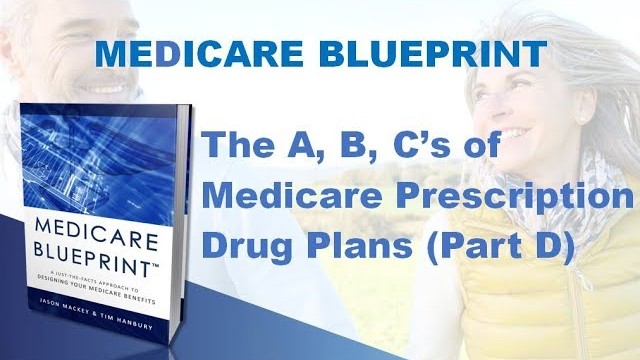The A, B & C’s of Medicare Prescription Drug Plans (Part D) explained by Tim Hanbury and Jason Mackey, authors of Medicare Blueprint.
This part of Medicare is the most complex of “Part” of Medicare because it’s so different than what you have with an employer or individual plan.
Part D is broken down into four levels. You have a Deductible level, the Initial Coverage level, then the Coverage gap or the “donut Hole”, then you have the Catastrophic level. The good news is that most people won’t get past the Initial Coverage Level.
Level one is the deductible level. These plans can have up to a $405 annual deductible. Except for some generic medications, you will pay the full cost of your medications until your deductible is met.
Next is the initial coverage level. In this level, you will have either a copayment amount or you may pay a percentage of the cost depending on the medication and the insurance company offering the plan. You will have different costs for a generic medication, a preferred brand name and non-preferred brand name and specialty medications. You will continue in this level until your Total costs have reached $3,750 in 2018. At that point, you will transition into the
Coverage gap or Donut hole. Once you meet the donut hole, your cost for medications will be 35% for the cost of brand name medications and 44% for the cost of a generic medications. You will continue in this level until your total costs meet $5,000 in 2018. They will apply the discount that pharmaceutical manufacturers are required to give on the cost of brand name medications. In 2018, they are required to provide a 50% reduction in the cost of a brand name medication. In 2019, this goes up to 70% of the cost of a brand name medication. What this means is that in 2018, you pay 35% of a brand name medication but 85% of the total cost is applied to the donut hole. In 2019, this will go up to 95% of the total cost is applied to the donut hole, but your cost goes down to 25% of the cost of a brand name medication. There are some costs that will not be counted in the donut hole. The most notable is that the discounts on Generic medications. Once your total costs have exceeded $5,000 in 2018 and $5,100 in 2019, you will then be in the Catastrophic level. In this level, your cost for a generic medication will be $3.35 in 2018. The cost for a brand name will be either $8.35 in 2018 OR 5% of the cost, whichever is greater. You stay at this level for the rest of the year.
If you don’t sign up for Part D plan when you are first eligible, they will apply a penalty based on each month you didn’t have coverage and it’s a permanent penalty that will increase each year.
While this penalty isn’t as large as the penalty under Part B of Medicare, it can add to your cost as this is “in addition” to the plan premium that you will pay. In most states, there are inexpensive plan options that are between $15 to $20 dollars.
As with Part B of Medicare, if you areconsidered a “higher income” individual, there will be an Income Related Monthly Adjustment Amount based on your income from 2 years ago. Again, like with Part B, if you have a situation where you will be making less money once you are on Medicare, like retiring and not earning a wage, you can apply for a “Life Event” change form and ask for a new initial determination.
How do I pick from the dozens of plans that are available?
Medicare.gov has an excellent tool to help with this. When you go to Medicare.gov, on the home page you will find a green box called “Find Drug and Health Plans”. When you click on the box, it will take you to the plan finder tool. There are also other ways you can do this. You can work with an agent who can do this with you, you can call the insurance company that is offering the plan, or you can call Medicare directly and they will do the work for you.
Here are the things you need to know when you are looking at coverage. You must review the listing of the covered medications, to make sure your medications are covered under the plan. You need to do this prior to signing up for a plan and then each year after because the formulary can and will change each year. You need to look at what pharmacy you want to use. This can have an impact as the pharmacy you want to see may not participate with the plan you are considering, and some pharmacies will have lower costs for your prescriptions. We recommend that you get a prescription plan when you are first eligible for coverage. You never know when you may need to get a prescription, one antibiotic can cost hundreds of dollars.
Free Offer
Complimentary Copy of Medicare Blueprint
Helpful Resources
Medicare & You Guide
Medicare Premiums: Rules for higher-income beneficiaries
Medicare Blueprint Advisors
MedicareBlueprint.com
Facebook:
YouTube Channel:






